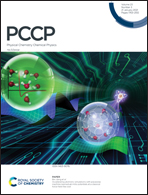DNA threading intercalation of enantiopure [Ru(phen)2bidppz]2+ induced by hydrophobic catalysis†
Abstract
The enantiomers of a novel mononuclear ruthenium(II) complex [Ru(phen)2bidppz]2+ with an elongated dppz moiety were synthesized. Surprisingly, the complex showed no DNA intercalating capability in an aqueous environment. However, by the addition of water-miscible polyethylene glycol ether PEG-400, self-aggregation of the hydrophobic ruthenium(II) complexes was counter-acted, thus strongly promoting the DNA intercalation binding mode. This mild alteration of the environment surrounding the DNA polymer does not damage or alter the DNA structure but instead enables more efficient binding characterization studies of potential DNA binding drugs.
![Graphical abstract: DNA threading intercalation of enantiopure [Ru(phen)2bidppz]2+ induced by hydrophobic catalysis](/en/Image/Get?imageInfo.ImageType=GA&imageInfo.ImageIdentifier.ManuscriptID=D0CP00845A&imageInfo.ImageIdentifier.Year=2021)


 Please wait while we load your content...
Please wait while we load your content...